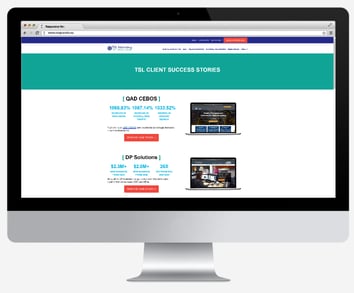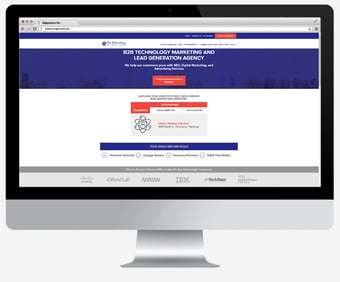Proven Techniques that Build Trust in Your Website

May 28, 2020

As potential customers quickly comb the internet for solutions to their business problems, you don’t have long to earn their trust and keep them on your website to continue their buyer’s journey.
To stay competitive and convince visitors that you’re the last stop in their search, you need to be able to show them, at a glance, more about who you are. Trust-building elements on your website highlight your accomplishments and service specialties without a heavy read required from the user.
From business partner and client logos to testimonials and success stories, verifications of trust allow your website visitors to see who vouches for you in the IT and business community. They establish your company as a trustworthy business, a thought leader, and a business with whom other companies have had success with.
Read our suggestions below for examples of ways to build trust on your website from a User Experience perspective and see some of the trust signals that TSL includes on its website.
Logos and Badges Prove Partner Trust
Business support organizations and technology companies don’t just give their thumbs up for any entity. It has to be earned through a proven partnership, which can involve documented training, event participation, or a successful sales background.
Your potential clients need to know that you work with best-in-class vendors and partners.
Show off your hard work and dedication with:
- Partner logos: channel partners and product manufacturers
- Specialty certification badges: especially if they’re technical and/or coveted in your industry
- Recognition emblems: such as a veteran-owned business or women-owned business
- Awards: community-recognized accomplishments and acknowledgments
TSL is a Diamond HubSpot Solutions Partner, and we proudly display this badge on many of our website and blog pages. We also dedicated a page on our website to highlighting our HubSpot services and created a Success Story page on how we helped one of our B2B tech clients migrate to HubSpot Marketing Hub Enterprise.
Logos and certification badges give new website visitors a way to see that the company is vetted by industry leaders. Trust signals help potential clients see that a business delivers on its promise of high-quality services.
Case Studies & Success Stories Add Context
Potential customers want to know how you’ve help businesses like theirs. Recognizing your past clients’ names, in testimonials for example, can pass on a social approval.
In some cases, however, companies you’ve helped will want to remain anonymous, due to company confidentiality policies or nondisclosures. These stories still hold merit, as their journey and subsequent success is most important, and can be used with a descriptive industry title instead of a proper company name.
Earn credibility by showing a new user that you have had success by including:
- Company stats: how long you’ve been in business, how many experts you have on your team, customer satisfaction score
- Links to online ratings: independent platforms where customers submit user feedback
- Testimonials section or page: direct quotes solicited from customers about your products and services
- Customer use cases and case studies: detailed stories with facts about how your company has solved specific challenges
- Partner page: this can be minimal and just feature logos, or could become more extensive to showcase featured company descriptions
- About Us page: gives readers a quick overview of your company history and specialties. Special note: in reviewing hundreds of websites, we have seen that the About Us page is a heavy hitter, so give it some meaningful content and relevant CTAs.

Above is TSL Marketing's case studies page. We've created this main overview page to link to several of our individual success story pages. Website visitors can land on this page to quickly see success highlights for some of the clients we've worked with or choose to dive deeper to explore an entire project journey, such as details about our marketing experience with a freight transportation company.
If a website visitor is interested in your company and they see that there are testimonials, case studies, and user ratings available, they can then hear from a business like themself that has had success and read how their experience went. This content also acts as a product review, which is an important step in any buyer’s journey.
Ideal Location for Trust-Building Elements
Your home page should host as many of these verifications of trust as possible, which is especially beneficial for someone who doesn’t know anything about your company and is brand-new to your website. If you have a lot of verifications available and are worried about crowding the homepage, try to prioritize what will have the biggest impact on new visitors to your website. Additional verifications of trust can (and should) be then added to interior pages.
Part way down our TSL Marketing home page, we display a section to showcase the logos of some of our technology company partnerships. If a reader clicks on this image, they are led to our Partnerships page, which offers a description of each partner company, along with testimonials from other clients.
You also should weave verifications of trust throughout your website as much as possible, but be mindful that you are providing meaningful information based on the page content.
Using CTAs, you can drive a user to more in-depth trust-building content from other services or About pages to give them a great path on which to take the next step in their buyer’s journey.
Benefits of Verifications of Trust
Having trust signals on your website aids your conversion rate optimization strategy by leading a potential client down a path of impressive company highlights to influence them in the consideration stage.
Adding trust-building elements is mostly for the user. We want them to see the client as credible and trusted. Having client quotes, outside recognition like awards and certifications, and logos of trusted partners can help users make quick decisions about the credibility of the business.
If a customer isn’t ready to convert on your offer yet, having those trust signals built out on your website gives users a way to take a next step in their journey when they’re not ready to fully commit.
From a networking perspective, including these verifications of trust helps to strengthen relationships with your current vendors and partners and gives your sales team another angle when talking about your products and services by pairing your company name with globally known, successful companies or organizations in your industry.
Would your website be more complete with trust-building elements such as case studies and testimonials? We understand that acquiring resources to action these tasks requires marketing budget, and it can be difficult to prove the outcome of that spending to obtain funds. For helpful tips, read our eBook The Art of Persuasion: How to Get Your Marketing Budget Approved.


